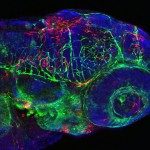Link to Pubmed [PMID] – 12177195
J. Neurosci. 2002 Aug;22(16):6972-9
Glial fibrillary acidic protein (GFAP), the principal intermediate filament (IF) protein of mature astrocytes in the CNS, plays specific roles in astrocyte functions. GFAP has multiple phosphorylation sites at its N-terminal head domain. To examine the role of phosphorylation at these sites, we generated a series of substitution mutant mice in which phosphorylation sites (Ser/Thr) were replaced by Ala, in different combinations. Gfap(hm3/hm3) mice carrying substitutions at all five phosphorylation sites showed extensive decrease in both filament formation and amounts of GFAP. Gfap(hm1/hm1) and Gfap(hm2/hm2) mice, which carry substitutions at three of five sites and in different combinations, showed differential phenotypes. Although Gfap(hm3/hm3) mice retained GFAP filaments in Bergmann glia in the cerebellum, the (Gfap(hm3/hm3):Vim(-/-)) mice lacked GFAP filaments. Pulse-chase experiments of cultured astrocytes indicated that the Hm3-GFAP encoded by Gfap(hm3) was unstable particularly in the absence of vimentin, another IF protein. These results revealed the role of phosphorylation in turnover of GFAP and a synergistic role of GFAP and vimentin in the dynamics of glial filaments. The data further suggest that each of the phosphorylated sites has a distinct impact on the dynamics of GFAP.
